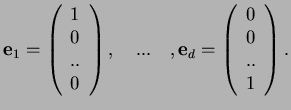



Next: The Hilbert space
Up: Math: Examples of Hilbert
Previous: Math: Examples of Hilbert
Contents
This vector space has a basis
of unit vectors  ,
,
 |
|
|
(168) |
Vectors are columns and in printed text written as the transposed (symbolized
by  that is sometimes omitted) of lines
that is sometimes omitted) of lines
 .
The scalar product of two vectors
.
The scalar product of two vectors
 , is
, is
 .
Each vector
.
Each vector
 can be decomposed into
can be decomposed into
 |
(169) |
Tobias Brandes
2004-02-04

